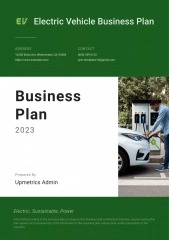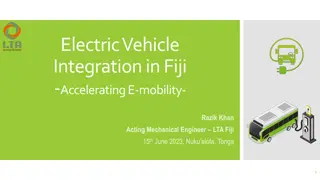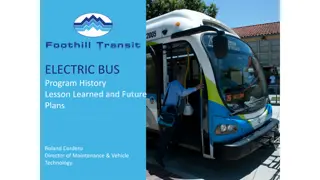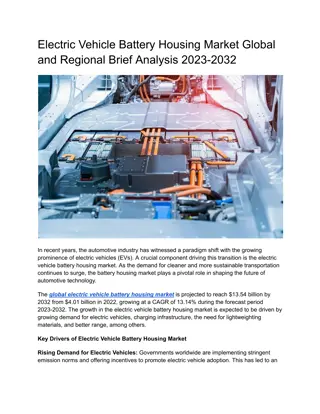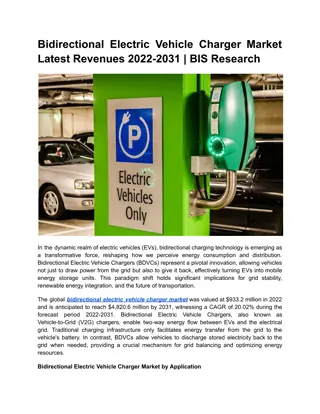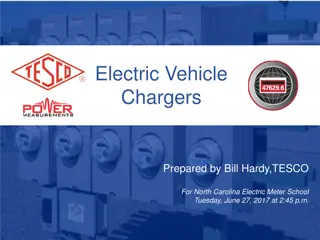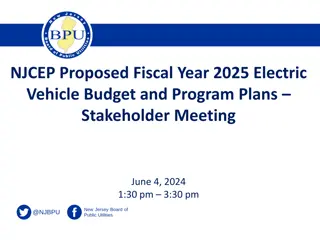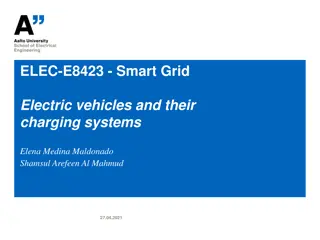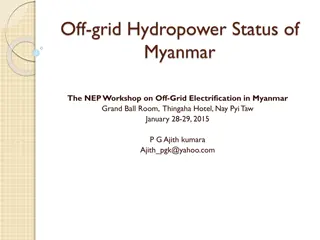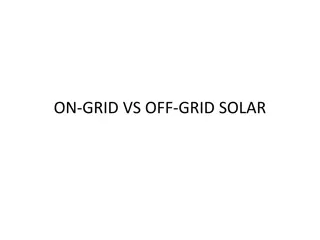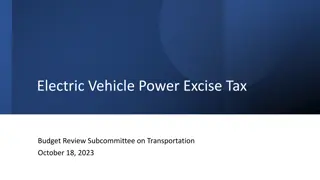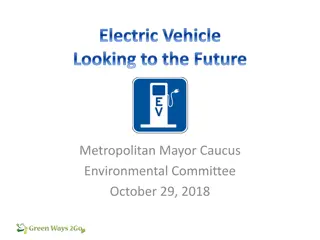Electric Vehicle Grid Impacts and Management Strategies
Consumer advocate Caroline Palmer discusses the potential costs and benefits of transportation electrification for ratepayers. She highlights the impacts of unmanaged EV charging on the grid and proposes various strategies to mitigate these challenges, including dynamic rates, passive managed charging, and Automated Load Management systems. These solutions aim to reduce grid demand, optimize charging patterns, and support transportation electrification goals efficiently.
Download Presentation

Please find below an Image/Link to download the presentation.
The content on the website is provided AS IS for your information and personal use only. It may not be sold, licensed, or shared on other websites without obtaining consent from the author.If you encounter any issues during the download, it is possible that the publisher has removed the file from their server.
You are allowed to download the files provided on this website for personal or commercial use, subject to the condition that they are used lawfully. All files are the property of their respective owners.
The content on the website is provided AS IS for your information and personal use only. It may not be sold, licensed, or shared on other websites without obtaining consent from the author.
E N D
Presentation Transcript
Utility Transportation Electrification from a Consumer Advocate Perspective Caroline Palmer | June 13, 2022
Potential Costs to Ratepayers Transportation electrification can benefit ratepayers Reduced GHG emissions Decreased local air pollution Downward pressure on rates (if EV load is properly managed) Transportation electrification can also incur outsized ratepayer costs, with significant equity impacts Utility charging infrastructure investment (utility-owned or not) Rate designs that cause cross-subsidies Need for power system upgrades due to EV grid impact 2
EV Grid Impacts If unmanaged, a majority of EV charging could occur during peak periods Distinction between distribution and system-level peaks Source: Pacific Northwest National Laboratory. https://www.pnnl.gov/sites/default/files/media/file/EV-AT-SCALE_1_IMPACTS_final.pdf 3
Mitigating EV Grid Impacts Program Type Approach Examples TOU and CPP rates Dynamic rates Monthly incentives for avoiding on-peak charging Subscription rate for off-peak charging Throttle/stop charging during demand response events Stagger charging sessions to avoid timer peaks Align charging sessions with periods of low energy costs or high renewable energy production Software: power sharing if a site exceeds a certain amount of demand Hardware: co-locating EVs with storage to reduce grid demand Passive managed charging Rely on customer behavior to affect charging patterns Active managed charging Direct load control (i.e., dispatch signals) from a utility or aggregator to control charging in a predetermined manner Automated Load Management (ALM) Limiting a site s grid demand to lower than its nameplate capacity 4
Automated Load Management/EV Energy Management Systems Limits the charging site capacity to a predetermined level, reducing the size of the required connection When a station s total nameplate load would otherwise exceed the rated capacity of the customer connection Benefits of ALM: Reduce the need for (and costs of) make-ready infrastructure on both sides of the meter Allow for charger deployment at locations with physical limitations Stretch investment dollars further in support of transportation electrification goals Image source: Virta. https://www.virta.global/blog/what-is-dynamic-load-management 5
Supporting EV EMS/ALM Deployment 1. Allow for the use of ALM to avoid upgrades under line extension policies Adding on-site storage to a maximum charging capacity reduces required connection size by the storage capacity - 2. Include ALM in customer education and outreach efforts Ensure potential site hosts are informed about ALM - 3. Incorporate ALM into site assessment process Evaluate each site to determine suitability for and potential ratepayer benefits of ALM - 4. Incentivize customers installing charging infrastructure to adopt ALM Exposure to customer- and utility-side make-ready costs - 6
Best Practices in Load Management Implementation A robust load management plan must accompany any ratepayer-funded EV charging investments Avoid over-building and over-spending Provide diverse load management offerings Including active and passive managed charging and EV EMS/ALM Ensure that utility has process for iterating on LM plans rapidly Not just in a rate case Demonstrate to regulators how load management offerings integrate with distribution system planning processes Importance of load forecasting 7
Implications for Distributed System Planning Which load profile is the utility assuming for distributed system planning? Figure source: National Renewable Energy Laboratory. https://www.nrel.gov/docs/fy21osti/73762.pdf 8
Networked EVSE and Vehicle Telematics Direct load control can be done by networked EVSE and/or vehicle telematics Programs should be tech-agnostic to maximize customer eligibility and enrollment - Technology Benefits Allow some older vehicle models without telematics functionality to participate Suitable for charging sites with many users (e.g., public & workplace chargers) Functionality already embedded in vehicle Allow drivers without a dedicated charger/parking space to participate Allow drivers with L1 chargers or non-networked L2 chargers to participate Networked EVSE Vehicle telematics Networked EVSE and/or vehicle telematics can also serve as submeters for EV charging Using the metering capability of smart chargers in lieu of a separate meter - 10
Benefits of Managed Charging With 1.5 million EVs in California by 2025: Unidirectional managed charging can provide an equivalent of 1 GW/2.9 GWh of stationary storage capacity, avoiding up to $1.75 billion in capital investments Bidirectional managed charging can provide an equivalent of 5 GW/30 GWh of stationary storage capacity, avoiding up to $15.4 billion in capital investments Data: Lawrence Berkeley National Laboratory. https://www.researchgate.net/publication/325164093_Clean_vehicles_as_an_enabler_for_a_clean_electricity_grid. Image: Bloomberg. https://www.bloomberg.com/news/articles/2018-02-25/why-charging-your-electric-car-at-night-could-save-the-world 11


